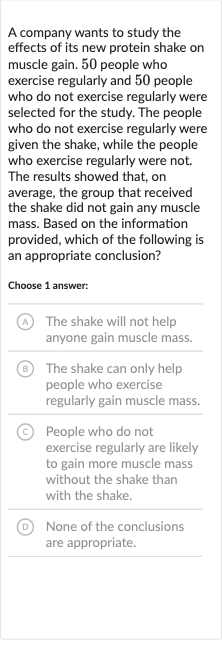AI tutor
Welcome to Bytelearn!
Let’s check out your problem:

A company wants to study the effects of its new protein shake on muscle gain. people who exercise regularly and people who do not exercise regularly were selected for the study. The people who do not exercise regularly were given the shake, while the people who exercise regularly were not. The results showed that, on average, the group that received the shake did not gain any muscle mass. Based on the information provided, which of the following is an appropriate conclusion?Choose answer:(A) The shake will not help anyone gain muscle mass.(B) The shake can only help people who exercise regularly gain muscle mass.(C) People who do not exercise regularly are likely to gain more muscle mass without the shake than with the shake.(D) None of the conclusions are appropriate.
Full solution
Q. A company wants to study the effects of its new protein shake on muscle gain. people who exercise regularly and people who do not exercise regularly were selected for the study. The people who do not exercise regularly were given the shake, while the people who exercise regularly were not. The results showed that, on average, the group that received the shake did not gain any muscle mass. Based on the information provided, which of the following is an appropriate conclusion?Choose answer:(A) The shake will not help anyone gain muscle mass.(B) The shake can only help people who exercise regularly gain muscle mass.(C) People who do not exercise regularly are likely to gain more muscle mass without the shake than with the shake.(D) None of the conclusions are appropriate.
- Comparison of Two Groups: The study compared two groups: people who exercise regularly and people who do not.
- Shake Given to Non-Exercising Group: The non-exercising group was given the shake, but they did not gain any muscle mass.
- Inconclusive Results for Exercising Group: Since only the non-exercising group received the shake and they did not gain muscle, we cannot conclude about its effect on those who exercise.
- Incorrect Broad Conclusion: Therefore, option ext{(A)} is incorrect because it's too broad; the shake might still help those who exercise.
- Incorrect Testing of Shake: Option (B) is also incorrect because the study did not test the shake on people who exercise.
- Unsupported Conclusion: Option (C) is not supported by the study since it did not compare muscle gain with and without the shake in the non-exercising group.
- Appropriate Conclusion: Option is the most appropriate conclusion since the study does not provide enough information to make a definitive conclusion about the shake's effectiveness.
More problems from Interpret confidence intervals for population means
QuestionGet tutor help
QuestionGet tutor help
QuestionGet tutor help
QuestionGet tutor help
QuestionGet tutor help
QuestionGet tutor help
QuestionGet tutor help
QuestionGet tutor help
QuestionGet tutor help
QuestionGet tutor help
